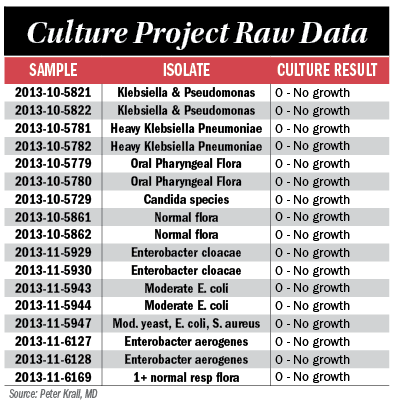Article
Cultures in evaluating donor corneal tissue for transplant
A small study of donor corneal tissues has shown that positive sputum cultures prior to death are not correlated with positive graft cultures after preparation. Despite the presence of low levels of various pathogens, no growth was found in any bacteria or fungus rim cul-tures.
Take-home:
A small study of donor corneal tissues has shown that positive sputum cultures prior to death are not correlated with positive graft cultures after preparation. Despite the presence of low levels of various pathogens, no growth was found in any bacteria or fungus rim cultures.

Dr. Krall
By Nancy Groves; Reviewed by Peter Krall, MD
Vista, CA-Current screening practices for donor corneal tissue include donor nasal and sputum cultures. However, a recent study suggests that automatically excluding samples with certain pathogens, such as Pseudomonas, or obtaining medical consultation for clearance, may be unnecessary, said Peter Krall, MD, one of the investigators.

No growth was found in any bacteria or fungus rim culture from donors with positive sputum cultures prior to death either during standard 5 to 7 day incubation times or an extended period of up to 3 weeks.
If these findings are confirmed in larger studies, they could prompt re-examination of eye bank infectious screening policies and more efficient use of scarce donor tissue, said Dr. Krall, in private practice, Vista, CA.
At the time the study was conducted, he was a cornea fellow in the Department of Ophthalmology at the University of Florida and conducted the research with colleagues there as well as with the Lions Eye Institute for Transplant and Research in Tampa. Dr. Krall’s mentor, Anup Kubal, MD, was the lead researcher on the project.
Both organizations were looking for new research projects and became interested in screening practices for sputum cultures after being unable to locate any studies showing a correlation between positive sputum culture and increased contamination of corneal grafts, Dr. Krall said.
Implications of research
Medical directors of eye banks are likely to reject donor tissue with certain isolates to reduce the risk of contamination, no matter how small that risk may be. If it could be shown that a positive sputum culture had no correlation with a subsequent positive graft culture, then the transplant culture could benefit.
“If we can save as much tissue and rule in as much as possible, that means more tissue for more procedures around the world,” Dr. Krall explained.
The researchers provided background data on the frequency of isolates from 2,000 sputum cultures. Yeasts were present in 7.0%, normal flora in 6.1%, S. aureus in 4.3%, Klebsiella in 2.5%, Acinetobacter in 2.0%, Streptococcus and E. coli each in 1.5%, and several others in less than 1% of samples. This suggests that a low level of pathogens is not uncommon.
For their study, the researchers obtained corneoscleral rims that had already been excluded from transplant due to low endothelial cell counts; rims from individuals with sputum cultures positive for methicillin-resistant Staphylococcus aureus (MRSA) were automatically excluded. The sputum isolates included a variety of microorganisms, such as Candida spp. and Pseudomonas spp.
The researchers sampled 18 rims, obtaining samples for bacteria and fungus from each. The cultures were developed for 5 days for bacterial cultures and 7 days for fungal cultures before being scored on a scale of 1 to 4. The score was 0 following both the normal and extended incubation periods.
Future study
“It is definitely a small sample size, but I think it is in line with other research that shows there’s no correlation between a positive sputum culture and that particular bacteria showing up in the corneoscleral rim culture,” Dr. Krall said.
Larger studies would be needed to confirm the findings and lead to changes in eye bank procedures.
“The implications are pretty big going into the future if we can definitely prove that there isn’t a correlation between any sort of sputum culture and the corneal grafts being contaminated. That’s the main point of the project,” he added.
Peter Krall, MD
P: 952/454-5002
E: peterkrall@gmail.com
This article was adapted from a poster presented at the 2014 meeting of the Association for Research in Vision and Ophthalmology. Dr. Krall has no relevant commercial disclosures.
Newsletter
Don’t miss out—get Ophthalmology Times updates on the latest clinical advancements and expert interviews, straight to your inbox.




